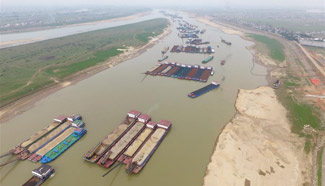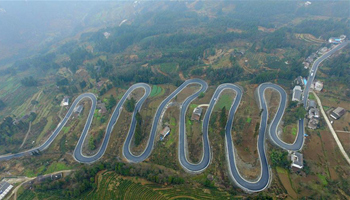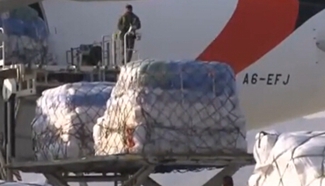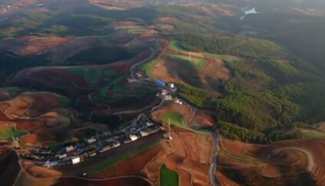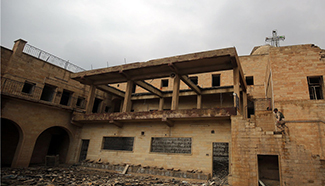SHIJIAZHUANG, Feb. 20 (Xinhua) -- Four years ago, Liu Jun had a argument with his father about whether to expand production at the family's glass factory or to upgrade the existing production lines.
The company, Huijing, started producing raw glass in 2003. By 2013 -- when Liu's father suggested the addition of a new line to boost production -- it had five production lines for sheet glass.
But Liu, the company's general manager in Shahe, a county-level city in north China's Hebei Province, thought it was not a good idea.
"My father believed the company could achieve greater success simply by adding more production lines," he said. "I felt it would lead nowhere as domestic glass industry was already struggling."
Factories in Shahe, the "City of Glass," produce about 160 million weight cases of flat glass annually, 20 percent of all glass produced in China.
The son won the argument.
The company branched out and began to make glass products with its own materials, including energy-saving windows and doors, and turned discarded foam glass into frames and boxes.
The company exported more than 3 million U.S. dollars worth of products to Walmart last year, and it inked a deal worth 20 million dollars with Walmart at the beginning of this year.
The success did not come easy.
The company's transition efforts were seen by many other glass makers as "a waste of energy and resources." Those same companies rued not making the same decision when demand for glass plummeted in 2014.
Partly due to the sluggish property market, China's architectural glass production capacity has been redundant since 2010, but high-tech glass products are in high demand. Some high-tech glass products are still imported, said Wu Zihong, deputy director of Glass Industry Operation Center of Shahe Economic Development Zone.
Besides, Shahe must address environmental issues. Before mid-2014, Xingtai ranked consecutively at the bottom of air quality rankings among 74 Chinese cities. For Shahe, reducing smog and the capacity of its heavily consuming and polluting glass makers seemed a matter of urgency.
However, the problem was that although all of Shahe's glass producers' discharges were within the standard, there remained the possibility that their combined emissions would exceed environmental tolerance because of the high concentration of glass businesses in that area.
Under those circumstances, the city made reducing pollution a precondition for all glass enterprises, pushing them to pursue an environmentally-friendly transition.
Zeng Shebin, director of Shahe's Environmental Protection Bureau, said all assembly lines in Shahe must be capable of desulphurization, denitrification and dust collection.
China requires each glass maker to keep its emissions of sulfur dioxide below 400 milligrams per cubic meter and that of nitrogen oxide below 700 milligrams per cubic meter. In Shahe, the two standards are 250 and 500 milligrams per cubic meter, respectively, Zeng said.
"What we are doing sends the message that we are serious," Zeng stressed.
Commonly, glass furnaces are kept burning for six to eight years for continuous production.
It takes about 70 million yuan (10 million U.S. dollars) to reignite an extinguished furnace, said Zhang Shengyun, chairman of glass producer Shabo Group. "It is less costly to install expensive equipment for desulphurization, denitrification and dust collection."
The environmentally-friendly measures have proved to address industrial overcapacity. From 2011 to 2015, Shahe phased out 57 glass businesses and 66 outdated production lines, reducing 48.6 million weight cases of glass production capacity, 163 percent of the province's target.
Last year, Shahe got rid of all sheet glass production lines and 21.8 million weight cases of flat glass.
Statistics provided by the Shahe government showed that local glass businesses have spent about 1.6 billion yuan on curbing pollution with all of their 52 operating production lines featuring environmentally-friendly facilities.
Local glass producers and experts agree that while strict environmental policies increase the cost of glass production in the short term, they help upgrade techniques and extend industrial chains for a more value-added, less energy-consuming model.
Liu's company was among the first to reap the benefits of the transition. In 2016, the company's frames were sold to U.S. retailers, including Walmart and Home Depot.
"The frame business is going very well," Liu said.
Shahe and Wuhan University of Technology jointly established a glass technology institute to develop new products.
Meanwhile, a new public service platform is helping local glass manufacturers develop their own techniques.
As a result, there are a growing number of glass makers achieving success in their transition. Statistics indicate Shahe now has over 600 further-processing glass businesses, which use over 64 million weight cases of raw glass a year for production of over 1,000 kinds of processed glass products.

